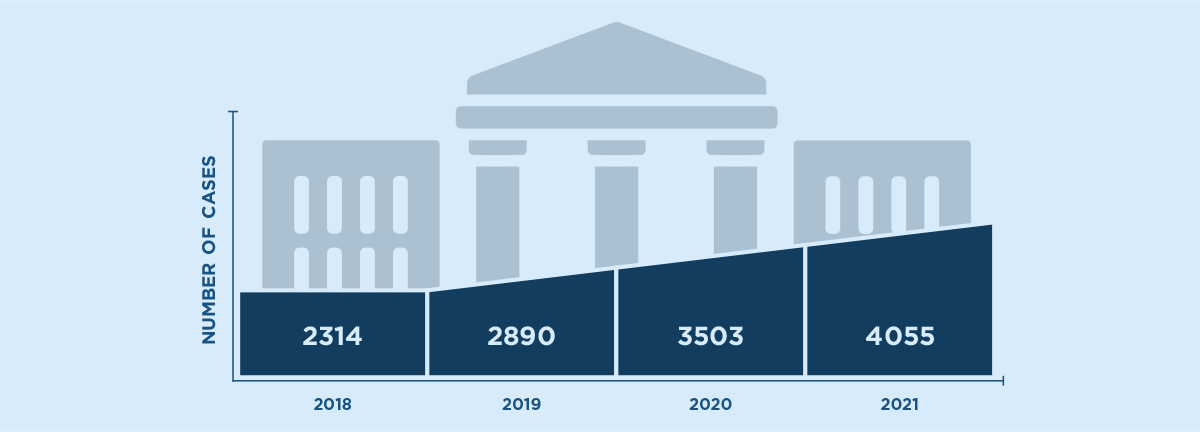Our annual report is out and below are the highlighted trends we are seeing along with some color behind the numbers. This report is now in its fourth year and is published twice a year. The data is used by over 200 different news and content outlets along with being used in key cases including the Domino's cases noted in front of the Supreme Court. Digital Lawsuits have helped bring significant attention to the need to ensure all digital experiences should be usable by all.
Want to see the latest number of lawsuits? Check out the first ADA lawsuit tracker to see the total number of lawsuits from the previous month.
The full report is free. Download here.
The UsableNet research team monitors and documents all digital accessibility-related lawsuits where a website, mobile app, or video content is the subject of a claim in federal court under the ADA or in State court under ADA-related laws such as the Unruh Civil Rights Act in California. The following report outlines trends found during 2021. Data and images can be shared when referencing UsableNet as a source and linking to www.usablenet.com
The Big Numbers

ADA-based cases, where the subject of the claim was either a website, mobile application or video content, reached a rate of over 10 per day in 2021 with over 4000 in total. That is a 15% increase from 2020. Cases counted include those filed in federal court and those filed in State courts such as California under the Unruh Act with a direct reference to violation of the ADA. The trend of increased California-based cases, both federal and state is continuing due to the damages ($4000) that can be claimed under the Unruh Act and the Dominos case that has set both websites and apps subject to the ADA.
Prepare for More Than One Lawsuit

Many companies have received multiple ADA-based lawsuits. Often, the first lawsuit is for the website and the second for a mobile app. Additional lawsuits have been filed against the same website, app, or another related brand in the case of a holding company. In some instances, the same website receives lawsuits from different plaintiffs. The bottom line is if websites, mobile apps, and content are not accessible, there is a chance to receive multiple ADA lawsuits, regardless of how many times a settlement has been reached. The best defense against repeat lawsuits is to rapidly improve the accessibility of all public-facing digital experiences.
Key Cases Bring Some Relief and Re-focus on Connecting to Brick and Mortar

Key court decisions this year have affected the volume of cases in different ways. The Winn-Dixie ADA appeal decision in Florida's Eleventh Circuit was good news for companies facing federal website accessibility lawsuits. The latest ruling in Florida was that non-e-commerce sites were not subject to the ADA. As Florida had many lawsuits against Hotel and other non-e-Commerce sites, the volume of cases and reduced significantly. On the other hand, New York case decisions in 2021 had judges reviewing the original wording of the ADA and siding with the defendants that had mainly digital-only websites. So, that has reduced cases against media and content-only sites, however, it has not cooled the number count. It has re-adjusted the attention of plaintiffs to focus on companies with digital and physical locations such as retail, venues, banks, etc.
E-Commerce Companies, Any Size, Selling Anything, Need to Take Notice

For the reasons above along with a range of other factors (complicated websites, frequently changing, sites with 3rd party features) 412 of the Internet Retailer Top 500 list received an ADA-based digital lawsuit related to one of their brands in the last 4 years.
Large e-commerce sites are complex, changing content and code often, and many have also a physical location (nexus). This combination makes them very likely to receive lawsuits if they do not have a strong accessibility program in place.
Outside the top 500 e-commerce sites, the percentage of companies sued with revenue below 50 million per year is growing. This could be a natural progression or due to changing consumer trends. Many of the largest companies have already been sued and have accessibility programs, which would make for a natural progression to smaller companies. The increase in e-commerce sales due to the pandemic has also brought more attention to smaller, up-and-coming e-commerce brands.
Top Plaintiffs and Plaintiff Firms Dominate Landscape
The top 10 Plaintiff Firms file three-quarters (75%) of all digital ADA Lawsuits. While the top ten defense firms represent less than 15%.
Top firms and plaintiffs prepare over 30 cases a month, which takes time, effort, coordination, and process. It reflects a sense of “surf by” type efforts where the plaintiffs and firms are not truly trying to use the websites that are being sued; They’re seeing if there are accessibility issues on the sites and then will file claims if they find any.
No relief is offered by widgets or overlays

The promise to prevent ADA lawsuits by using an accessibility widget or overlays isn't real. Many lawsuits in 2021 list widgets and overlay features as a barrier to equal access in addition to other inaccessible aspects of the website. This means these approaches give plaintiffs more claims to add to a lawsuit, not less.
This is the 4th Year UsableNet has been tracking and reporting on these digital lawsuits and trends continue to increase in volume. This looks to be the continued trend until a more substantial effort is made to clarify the digital space within the ADA. This year did see more activity from the DOJ concerning targeted settlement so this activity could become more common in 2022.
UsableNet also provides regular updates from our legal partners on key cases and litigation trends, and what it means for our clients as well as the disability community.
A trusted partner can help you improve accessibility and reduce legal risk. Contact UsableNet for a free consultation with an accessibility expert.










